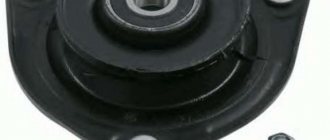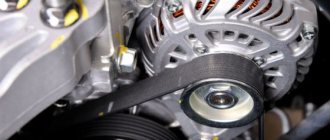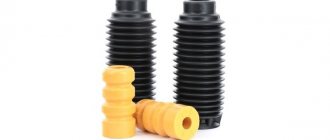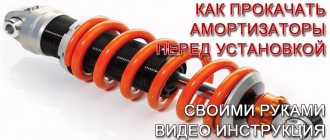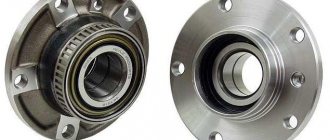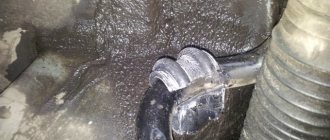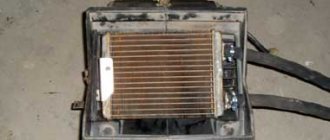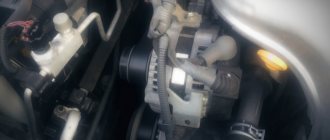Try it on!
The simplest, fairly quick and not so expensive way to get general information about the effectiveness of the suspension is to stop by a diagnostic stand, take measurements and listen to the verdict.
Another question is how precisely the verdict will apply directly to shock absorbers. The fact is that in the case of various kinds of “shaking” (of which there are more and more recently), the presence of at least one faulty element (not necessarily a shock absorber) will significantly affect the final results of the efficiency indicator. In addition, the algorithms by which the performance of the suspension are assessed differ, and diagnostics of one car on different stands can lead to the fact that the data obtained on the condition of the suspension may differ.
Varieties
Parts, the installation of which is carried out with special eyes, are supplemented with silent blocks or rubber bushings necessary for connection with the body and suspension of the car. It is worth noting that the upper support of the shock absorber strut has become most widespread in passenger vehicles.
Based on the type of construction, supports are classified into two types:
- composite;
- non-separable.
The latter are made in the form of a single element made of metal and rubber and are most often used in the front suspension. The main part of the structure is the connection of a rubber cushion with an internal and external steel bowl. Fixation to the body is made by the outer casing, which has several holes for fasteners. The rod is installed in the central part, and in the upper part there is a device for limiting backlash, which is similar to a steel bowl.
Shockabsorber-replacement-14_
There are known cases when, when diagnosing a car on a “shaky ride” with a working suspension and recently replaced shock absorbers, the data obtained indicated low residual effectiveness of the suspension. But during the “test drive” the car behaved perfectly. The reason is that the stand was not designed for more “hard” settings of the tuning series shock absorbers compared to the characteristics of the original products, as a result - a wrong verdict. Well, that happens.
A very important point! The final indicators may be influenced by such parameters as tire pressure, vehicle loading during diagnostics, small deviations from a straight line when driving to the stand (appearance of a deviation angle from the longitudinal axis), accidental installation of the vehicle on the handbrake, uneven loading of the vehicle during diagnostics, etc. .d. It will be a real pleasure for a careless repairman to “cheat” a client out of the cost of new shock absorbers, so that in the meantime, as if by accident, pump up his flat tire...
Shock absorber malfunction: symptoms and what affects
Shock absorber malfunctions greatly affect the car's behavior on the road. In particular, the car body “dives” during acceleration and braking, the braking distance increases, rolls heavily during maneuvering and sways when driving over uneven surfaces.
There are obvious and hidden signs of faulty shock absorbers. Obvious ones include the appearance of oil leaks (wear of the oil seal and/or rod), but there are more hidden ones, for example, aging of the oil, deformation of the valve mechanism plates, wear of the piston seal and the inner walls of the working cylinder. To avoid unpleasant consequences, you need to identify the faulty shock absorbers in time.
What is it for and how to check the support bearing of the front shock absorber
The most typical sign of support bearing wear is a knocking sound when turning the steering wheel, as well as when overcoming minor obstacles on the road. In addition, the strut sometimes pierces the body of the car, and this requires more significant costs than the usual replacement of the strut. Then you will have to straighten and paint the iron, and correct possible damage to the suspension.
Signs that may appear when the bearings are worn do not necessarily indicate this particular malfunction. They are also typical for other breakdowns.
If you hear a clear knocking or squeaking sound when rocking, then the bearing needs to be replaced urgently. Replacing the front support bearings is quite simple. Remove the two nuts securing the front strut to the hub. Unscrew the nut from the shock absorber rod, while holding it with a hexagon.
Signs of faulty shock absorbers
There are two types of signs that a shock absorber has completely or partially failed. The first type is visual. In particular, they can be identified by visual inspection of the shock absorber. The second type of signs includes changes in the behavior of the car in motion. Let us first list the signs related to the second type, since first of all it is necessary to pay attention to how the behavior of the machine has changed, in particular:
- Rocking when braking and accelerating . If the shock absorbers are working properly, then even with sharp braking the car should swing back no more than once, after which the shock absorber should dampen the oscillatory movements. If there are two or more swings, this is a symptom of partial or complete failure.
- Increased braking distance . This factor is due to the same swing during braking. That is, during prolonged braking, the shock absorber does not dampen vibration, and the car periodically lowers and raises the front part of the body. Because of this, the load on the front wheels is reduced, which reduces braking efficiency. The braking distance is especially longer for vehicles equipped with an anti-lock brake system. This is because the rear end rises and the ABS reduces the brake line pressure. Also, the braking distance increases when braking on uneven roads.
- The car does not “hold” the road . In particular, when the steering wheel is installed in a straight position, the car constantly pulls to the side. Accordingly, the driver must constantly steer in order to align the trajectory of movement.
- Discomfort when driving . It can manifest itself in different ways. In particular, some drivers and/or passengers feel discomfort from the rocking of the car when driving long distances; people suffering from “sea sickness” (the official name is kinetosis or motion sickness) can feel motion sick. This effect is a typical symptom of faulty rear shock absorbers.
Roll when maneuvering . Here the situation is similar; after exiting a sharp roll when entering a turn, the body should not sway in the transverse plane. If so, the shock absorber has similarly failed.
Please note that signs such as long braking distances, uneven tire wear and constant need to steer may indicate other problems in the vehicle, such as worn brake pads, low brake fluid levels, uneven tire pressures, problems with the ball joint or other components. pendants. Therefore, it is advisable to perform a comprehensive diagnosis. Visual symptoms of shock absorber wear include:
- The appearance of drips along the body and stem. In particular, this occurs due to wear of the oil seal (seal) and/or shock absorber rod. A decrease in oil level leads to a decrease in the operating amplitude of the device, as well as to an increase in wear of the parts included in its design.
- Wear of silent blocks. As is known, in this rubber-metal hinge, mobility is ensured due to the elasticity of rubber (or polyurethane, depending on the design). Naturally, if the shock absorber works hard, then increased forces will be transferred to the silent block, which will lead to its significant wear and failure. Therefore, when diagnosing shock absorbers, it always makes sense to check the condition of the silent blocks.
- Damage to the shock absorber housing and/or its fasteners. This can be expressed in different ways. For example, the appearance of rust on the rod (stand, support), curvature of the body, damage to the mounting bolts, and so on. In any case, the shock absorber must be carefully inspected.
- Uneven tire wear. They usually wear more on the inside and less on the outside.
It will be useful: Characteristics of dexron oils 2 and 3 for gur, is it possible to pour and mix?
That is, if there is a malfunction of the shock absorbers, then expect failure of other suspension elements, because they are all interconnected and can be influenced by each other.
Why do shock absorbers knock?
There are several known reasons for shock absorbers knocking on small bumps.
- Deformation of the rod. Counters and burrs on the working surface of the rod, as well as its deformation, will cause knocking. With these defects, the guide bushing breaks, and the rod “walks” in it, producing a characteristic knocking, often dull, sound.
- Lack of oil or gas in the shock absorber. After one of the working media leaks, the rack is no longer able to operate normally. Idling zones appear in which the piston does not transfer oil with resistance, as it should, but simply falls through or shoots off sharply under the influence of a spring.
- Damage to the bump stop. The bumper serves to stop the rod in its extreme position, that is, before it reaches the “dead point” and the impact falls on the rod or cylinder. If the bump stop wears out, the shock absorber strut begins to knock when driving through amplitude holes.
- Overloading the vehicle. One of the most common reasons why knocking occurs in the rear struts, especially after long runs. The free play between the bump stop and the body becomes less and less as the load increases. And when driving over even shallow irregularities, a shock appears: the beam hits the bump stop.
- Broken spring. If a spring breaks, depending on the area of damage, the strut as a solid structure loses its rigidity or stops functioning. Backlash appears between individual elements. This play causes knocking in the shock absorber strut.
What is the effect of a faulty shock absorber?
The use of worn shock absorbers can not only cause discomfort while driving, but also cause a real danger when driving the car. So, possible problems associated with a faulty shock absorber:
- Reduced wheel grip. In particular, when the car rocks, the clutch will have a variable value.
- Increased braking distance, especially on vehicles with an anti-lock braking system (ABS).
- Some electronic systems of the car, such as ABS, ESP (exchange stability system) and others, may not operate correctly.
- Deterioration in vehicle handling, especially when driving at high speed.
- The appearance of “hydroplaning” when driving on a wet road at low speeds.
- When driving at night, constant rocking of the front of the car can cause the headlights to blind oncoming drivers.
- Discomfort when driving. This is especially true when driving long distances. For the driver, this threatens increased fatigue, and for people prone to seasickness, this is dangerous due to motion sickness.
- Increased wear of tires, rubber bushings, silent blocks, bump stops and springs. and other elements of the car suspension.
We evaluate controllability when driving.
The design is considered faulty if, at a speed of over eighty km/h, the car begins to “scour” from side to side, as if in a rut. This behavior is also observed at lower speeds but on a road with a large number of irregularities along the course of travel - stability decreases sharply, vertical sway occurs, and extraneous sounds appear. During high-speed turns, the vehicle's response to the steering wheel decreases. Often, the development of symptoms occurs gradually and the driver gets used to such behavior of the car, not paying attention to the development of destructive processes in the design of shock absorbers.
Causes of shock absorber malfunction
The causes of failure are usually natural factors, including:
- Aging of shock-absorbing fluid (oil). Like other technological fluids in a car, the oil in the shock absorber gradually gains moisture and loses its performance properties. Naturally, this leads to the fact that the shock absorber begins to work harder than it worked before. However, it must be understood that fluid aging does not happen overnight, with the exception of a rupture of the seal on the shock absorber body.
- Torn seal. In particular, the sealing of the piston and the inner walls of the working cylinder. The oil seal can rupture due to external factors or simply due to the aging process. It, like any rubber seal, becomes tanned over time and begins to leak liquid. Because of this, oil leaks from the shock absorber, as well as moisture from the outside entering the oil, which leads to a deterioration in its performance.
- Deformation of the valve mechanism plates. This process is also natural and occurs on an ongoing basis, albeit at different speeds. Thus, the rate of deformation depends on two main factors - the quality of the shock absorber (the quality of the metal of the plates) and the operating conditions of the machine (naturally, a significant impact load leads to premature deformation).
- Gas leak. This is true for gas-filled shock absorbers. The idea here is the same as for oil-filled devices. Gas here performs a damping function, and if it is not there, then the shock absorber will not work.
- Failure of silent blocks. They wear out due to natural reasons, losing their elasticity and performance. These components are practically not subject to repair, so if they fail, they simply need to be replaced (if possible, or the shock absorbers must be completely changed).
Special stand
To get a complete picture, it is necessary to check the force of full exit and compression of the rod on a special stand, and in this case it is impossible to do without dismantling it. This diagnosis is the most reliable. The disadvantages include high labor intensity and, ultimately, cost.
After analysis, a decision is made on repair or replacement.
Now let's take a closer look at the causes of problems and how to troubleshoot shock absorber problems. Fluid is leaking from the shock absorber. There may be several reasons for this:
1. There is an excessive amount of fluid in the shock absorber - in this case, simply provide the required amount;
2. The reservoir nut is loose – tighten the nut;
3. The tank is damaged in the area of the sealing ring - replace or repair the tank;
4. Nicks on the rod, wear of the chrome coating - replacement of the rod and oil seal;
5. Damage to the reservoir sealing ring - replace the ring;
6. Damage or wear of the rod seal - replace the seal;
7. Damage or presence of large corrugations on the tank seal - replace the seal.
When driving, the shock absorber makes a knocking noise.
The first step is to check if fluid is leaking - this is often the most common cause of knocking, and if a leak is found, the easiest way is to replace the shock absorber. If there is no fluid leak, perform the previously described test - “rocking the car”. The knocking of the shock absorber can also indicate its wear, and if operation without replacement is more than 60 thousand km, repair or replacement must be carried out.
Another common cause of knocking is air entering the outer cylinder due to a fluid leak. You can fix the problem by bleeding the shock absorber, either with your own hands or at a service station.
A decrease in the density of the liquid due to loss of properties during prolonged operation or the use of oil not specified in the instructions.
The malfunction can be eliminated by replacing the fluid specified in the operating instructions. Loosening the cylinder nut. Tighten the nut, add or replace fluid if necessary. May occur in critically cold conditions. In such cases, the hydraulic fluid is replaced with a special, frost-resistant one, and do not forget to warm up the shock absorbers. Knocking can also occur after installing new shock absorbers.
Most likely, the reason is that they are installed on worn rubber bushings, or on shock absorbers that are unsuitable for this type of shock absorber.
Insufficient resistance of the shock absorber during forward travel (upward movement of the shock absorber rod).
The cause of this malfunction is often a leak in the bypass valve or recoil valve as a result of damage to parts, or a decrease in the stiffness of the compression valve spring. The malfunction should be eliminated by disassembling the valve and replacing parts that have become unusable. The problem can also be caused by: wear of the guide bushing, insufficient amount of fluid as a result of leakage, burrs on the piston or cylinder, decreased density and viscosity of the fluid. In all cases, replacement of damaged parts is required. Among other things, in the second option, add to the required amount, and in the third and fourth, replace the working fluid.
How to determine if shock absorbers are faulty
Car owners are not without reason concerned about the question of how to check an oil or gas-oil shock absorber. This is due to the fact that modern shock-absorbing devices often have a more complex design than older models, which makes diagnostic measures more complicated. Therefore, ideally, they should be checked in a car service center on a special stand. However, there are a number of “garage” verification methods.
Body rocking
The simplest, “old-fashioned” method is to rock the car body. In particular, they rock its front or rear part, or the shock absorbers separately. You need to swing it strongly, but do not bend the body elements (in practice, such cases occur!). In theory, you need to achieve the maximum possible swing amplitude, then release the body and look at its further vibrations.
If the shock absorber is working properly, the body will make one swing (or one and a half), after which it will calm down and remain in its original position. If the shock absorber has a malfunction, the body will make two or more oscillations. In this case, it must be replaced.
It is worth noting, however, that the rocking method is suitable for cars with a simple suspension system, for example, the VAZ “classic” (models from VAZ-2101 to VAZ-2107). Modern cars often use complex (often multi-link) suspension, so it will dampen the resulting vibrations even with faulty shock absorbers. Therefore, with the help of body rocking, by and large, it is possible to determine two borderline states - the damper is completely out of order, or it jams during operation. It is not easy to identify the “average” states of the shock absorber using swinging.
Visual inspection
When diagnosing a problem shock absorber, be sure to perform a visual inspection. To do this, you need to drive the car into a viewing hole or lift it on a lift. You can, of course, dismantle the shock absorber, but this can take a lot of time and effort. During the inspection, be sure to check for oil smudges on the shock absorber body. You can wipe off traces of oil with a rag and leave it like that for several days. After this period, the test should be repeated.
If the car is raised on a lift, it is advisable to check the condition of the shock absorber rods. They should not show any signs of rust or damage. If they are present, then the device is at least partially faulty and additional diagnostics need to be performed.
When inspecting, be sure to pay attention to the wear pattern of the tires. Often, when shock absorbers are broken, they wear unevenly; as a rule, the main wear occurs on the inside of the tire. There may also be isolated bald spots of wear on the rubber. However, tread wear may also indicate other failures in the suspension elements, so additional diagnostics are also needed here.
If faults in the front shock absorber (strut) are checked, a mandatory inspection of the springs and upper supports must be performed. Shock-absorbing springs must be intact and free of cracks and mechanical damage.
Machine control check
If the shock absorber/shock absorbers are faulty, then while driving the driver will feel that the car is “scouring” along the road, that is, it will be necessary to constantly steer in order to keep it in the rut. When accelerating and braking, the car will sway. The situation is similar with lateral body tilts. In this case, it is not necessary to accelerate to a significant speed; the city speed limit is quite suitable for testing. In particular, at a speed of 50...60 km/h you can do sharp acceleration, braking, and snake.
Visual inspection
The most reliable option is a visual inspection at the repair pit. By the way, this method is the cheapest. When inspecting shock absorbers, it is necessary to identify darkening from oil on the surface of the parts. Remember that there should be no oil drips here. This factor marks the loss of tightness of the shock absorber components. This means that such a shock absorber will not last long. If you doubt the result, such a shock absorber should be wiped dry, and after a couple of days, a visual inspection should be repeated. When examining the design, evaluate the condition of the anthers and the rebound buffer - traces of oil are also possible here. You can evaluate the shock absorber by examining the condition of the tires. If uneven wear patterns are visible on the edge of the tire, this is a “defect” caused by the influence of a faulty shock absorber.
When to change a shock absorber
It is necessary to understand that regardless of the quality of the shock absorber, as well as the operating conditions of the machine, wear of this unit occurs constantly. With more or less speed, but constantly! Accordingly, their condition also needs to be checked constantly. Most shock absorber manufacturers in the mid-price category recommend checking every 20...30 thousand kilometers . As for replacement, usually the shock absorber wears out significantly after approximately 80...100 thousand kilometers . At this stage, you need to check it more thoroughly and, if necessary, replace it.
To ensure that shock absorbers last as long as possible, follow these recommendations:
- Do not overload the machine . The manual for any vehicle directly states its maximum load capacity. You should not overload the car, because this is harmful to its various components - including the engine and suspension components, in particular shock absorbers.
- Let it get into working mode . When driving a car in the cold season (especially during significant frosts), try to drive the first 500...1000 meters at low speed and avoiding bumps. This will allow the oil to warm up and spread.
Thus, if problems arise with the shock absorbers, it is better not to tighten it and replace the problem units with new ones. As for the purchase, it is better to buy licensed shock absorbers from the “officials”. Or choose products in trusted stores based on reviews from car enthusiasts.
Support bearing in suspension device
The car suspension is one of the components of the chassis. The main function of the suspension is to provide an elastic connection between the body and the wheels of the car (smoothing vibrations transmitted to the car body while driving).
Depending on the design of the guide elements, there are several options for automobile suspensions:
- Independent option (the wheels are mounted on independent levers, which improves vehicle handling). Scope of application: front and rear suspensions of passenger cars.
- Semi-independent option (fastening a rigid beam using a torsion bar). Scope of application: front-wheel drive passenger cars, minibuses, the total weight of which is no more than 3.5 tons;
- Dependent option (presence of a rigid beam in the bridge component and ensuring parallel movement of the wheels in the transverse plane). Scope of application: trucks and rear axles of passenger cars.
Each component of the suspension has its own functional feature. Failure of at least one of the elements may lead to damage to other equally important components of the car, entailing repair work. For this reason, it is very important not only to properly operate and maintain the car as a whole, but also to be able to correctly diagnose a particular breakdown.
What functions does a support bearing perform?
The support bearings of the front struts are the main elements of the shock absorption system and are part of the MacPherson strut. Front support bearings of this type are installed on almost all front-wheel drive cars in which the movement of the shock absorber strut or shock absorber occurs simultaneously with the steering knuckles.
Support bearing: device and features
Support bearings are made of very durable material, as they are subject to heavy operating loads, especially when driving off-road. To avoid rapid wear, the supporting element is covered with a protective cover.
The bearing design is quite simple and consists of three main elements:
- top plate with fastening element;
- the bearing itself;
- the base of the cup (most often, this part of the support bearing is pressed into the top plate along with the bearing itself).
Depending on various technical and design characteristics, the front strut supports can be of several types:
- support bearing with a detachable inner ring (the outer ring is connected to the housing);
- support bearing with a detachable outer ring (the inner ring is connected to the housing);
- support bearing with a built-in inner or outer ring (the installation process occurs without the use of pressure flanges);
- single-split journal bearing (the outer ring is divided at one point, which greatly increases rigidity and ensures precise rotation of the outer ring).
How to determine when it’s time to change struts
symptoms and conclusions
You will feel the dying struts begin to beat, the consequences of the chassis breaking (step bearings) and repairs become more expensive.
for answer! This means that if nothing hits you yet, you can drive.
Can you clarify about “weak racks”. What exactly did the masters have in mind? Under this definition, it is quite possible to sum up the situation when the springs on the struts are tired and the car sags considerably when obese friends sit in the back seat. or the struts have lost their shock-absorbing properties - the rear of the car throws from side to side and sways after going through decent bumps. Perhaps oil streaks are visible on the racks - also a sign of tired racks. In general, it is not clear why and how. The most dangerous thing with tired struts is a decrease in vehicle controllability, which requires increased attention from the driver. This leads to increased driver fatigue and, accordingly, to an increased risk of getting into an accident.
It will be useful: Car stationary mini dvr video recorders: review of portable, small models
The car sways when the road is rough. Approximately how much do the racks and labor to replace them cost? How long will non-Japanese analogues last? So many questions. Like in a dark forest. Now I understand why people replace their cars with new ones every two or three years.
Take contract ones from 1500 rubles
Don't buy new ones, they won't last long anyway.
Take contract ones from 1500 rubles
Don't buy new ones, they won't last long anyway. I took it off, threw it away, and installed it. You can even pump the old ones if the oil hasn’t leaked, just pumping the gas without disassembling it will cost 100–150 rubles for six months. Making it collapsible is not an option.
That's how many people - so many opinions
